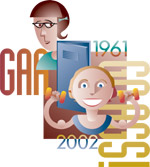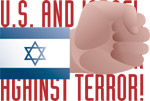BODY WORK
I’m back in gym class. I’ve got a locker with a combination lock, a towel that I have to show to the woman behind the desk before she’ll give me a fresh one and a workout routine. Tired of trying to fit in a visit to the health club either before or after a long workday, I decided to do it during the day via University Extension’s Noon Fitness class. So, three times a week, at noon on Monday, Wednesday and Friday, I leave my office and head for the women’s locker room in Hickey Gym.
It’s basic locker room decor—rows of blue lockers separated by long wooden benches, showers (some communal, some, thank goodness, with shower curtains), ugly ceiling that looks like cottage cheese mixed with coal dust. Brightly colored bathing suits hang drying outside lockers, straps captured in the loop of the combination lock. My own particular locker is in the last row, at the end. I think it’s just coincidence that the attendant assigned this one to me, but I’m relieved I’m not out there in the middle, undressing amidst women 40 years my junior; I’m in OK shape, but as I hurtle toward my 60th year I’m acutely aware that even vigorous exercise and a healthy diet are no match for the ultimate body-sculptor, gravity.
The last time I spent any time in this kind of environment it was 1961, and if I’d heard the words “Title Nine” I’d have thought they referred to a listing in a bibliography. We had gym clothes, not workout outfits, and when we girls played basketball, the rules said we could dribble the ball only twice before passing it to another of our frail teammates (and no stepping over the half-court line, please). The only organized sports group for girls was something called the Girls Athletic Association, or GAA, heavily populated by girls I thought of as unpopular. (Not that I was popular, you understand; it’s just that I wanted to be, and GAA was definitely the nadir of popularity. It was bad enough that I was what’s now known as a “band geek.” Cheerleading was really where it was at.)
Here, in the locker room and in the weight room, there’s evidence a-plenty of just how far women’s sports have traveled from those dim and dreary days.
As I change into my shorts and T-shirt, I think about the differences between my youthful so-called athletic experiences and those of these college-age women. The lockers belonging to members of the varsity teams (there are 13 of those teams for women, compared to 12 for the men) are plastered with inspirational quotes (“Try, try, try again,” reads one), messages of congratulation or encouragement from teammates and coaches, in-jokes and cartoons. These women revel in their athleticism, in their competitiveness, in their competence. I watch them in the weight room as they go through their routines, lifting respectable poundage, doing squats, stepping onto and down from a foot-high platform holding weights in their hands or leaping from side to side in what appears to be a variation on a Russian folk dance but is no doubt a drill to improve quickness on the field. There’s no apparent self-consciousness, no overt (or even covert) eyeing of the guys working out alongside them, no flirting. These women are here on business.
Back in the locker room after my hour of strength training, getting ready to return to the office, I sometimes wonder: If I’d been like these young women, if I’d had their opportunities to participate and excel in sports, would my life have been better? Or just different? Could I have been . . . a contender?

NO PEACE
On a too-warm-for-spring day in April, a group of about 100 stood on the edge of the Quad near the Memorial Union, waving blue and white Israeli flags and holding signs that said “Israel Wants Peace” and “U.S. and Israel Stand Together Against Terror.” Fifty feet away, an-other group of about 100 stood on the patio closer to the MU, holding signs that said “Stop U.S. Aid to Israel” and “End Israeli Apartheid” and waving red, white and green Palestinian flags. In between stood a half-dozen uniformed police officers.
The occasion was the first day of a Muslim Student Association regional conference, a weekend-long event held in Davis. The demonstration, called “Rally for a Free Palestine,” was the kickoff event and prompted the counter-demonstration by members of Aggies for Israel, who had marched over from Hillel House.
Having reached their respective spots, the two sides stood in silence, each quietly watching the other for many long minutes. Then as the pro-Palestinian group reached a critical mass—or maybe as they decided that the quiet standoff wasn’t enough—members began marching in a circle, chanting anti-U.S. and Israel slogans. The Israeli supporters, in turn, began singing Jewish songs. Louder and louder, as the Palestinian group continued to grow, as a portable amplifier was brought in, until the noise became an indistinguishable cacophony.
 Neither side took a step toward the other. There was no movement toward understanding. No one’s position changed. The groups remained apart, each within their own anger and grievances and conviction. Eventually the Palestinian supporters marched away toward Central Park. And spectators were left to wonder: Can there be hope for Israel and Palestine to take a step toward conciliation, if it can’t happen here, 7,000 miles away? Neither side took a step toward the other. There was no movement toward understanding. No one’s position changed. The groups remained apart, each within their own anger and grievances and conviction. Eventually the Palestinian supporters marched away toward Central Park. And spectators were left to wonder: Can there be hope for Israel and Palestine to take a step toward conciliation, if it can’t happen here, 7,000 miles away?

|

